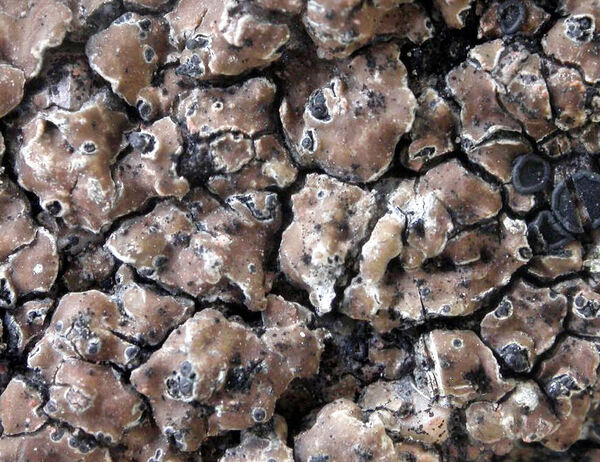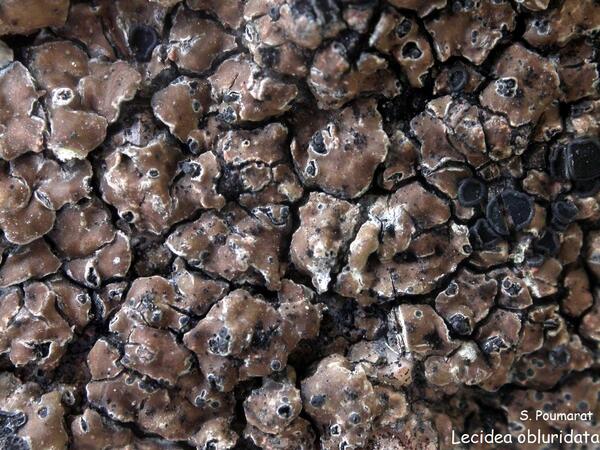Lecidea obluridata Nyl.
Flora, 56: 201, 1873.
Synonyms: Lecidea nigrogrisea Nyl.
Description: Thallus crustose, episubstratic, areolate, grey-brown or pale brown, more or less shiny, often delimited by a black prothallus, the areoles irregular in outline, concave to flat, often whitish at margins, 0.2-1.6 mm wide. Medulla white, I-. Apothecia lecideine, black, epruinose, arising between the areoles, round to angular in outline, (0.3-)0.5-1.3(-2) mm across, at first adnate then subsessile, with an initially flat,then usually convex disc and a thin, sometimes flexuose, persistent or finally excluded proper margin. Proper exciple thin, brown-black at least in outer part, K-; epithecium blackish green, with crystalline granules, K+ intensifying green, N+ deep purple-red; hymenium colourless, (40-)50-65(-75) µm high; paraphyses coherent, simple or sparingly branched in upper part, the apical cells slightly swollen, up to 3 µm wide; hypothecium brown, K+ deep reddish brown. Asci 8-spored, clavate, Lecidea_type. Ascospores 1-celled, hyaline, narrowly ellipsoid, (7-)9-13(-15) x (3-)4-5(-6) µm, 2.3-2.8 times as long as wide. Pycnidia black. Conidia short-bacilliform, 5-8 µm long. Photobiont chlorococcoid. Spot tests: cortex K-, C-, KC-, P-; medulla K+ faintly yellow, C-, KC-, P-, UV-. Chemistry: medulla with confluentic acid.
Growth form: Crustose
Substrata: rocks
Photobiont: green algae other than Trentepohlia
Reproductive strategy: mainly sexual
Poorly known taxon in need of further study
Commonnes-rarity: (info)
Alpine belt: absent
Subalpine belt: very rare
Montane belt: very rare
Dry submediterranean belt: extremely rare
Humid submediterranean belt: absent
Padanian area: absent
pH of the substrata:
1 2 3 4 5
Solar irradiation:
1 2 3 4 5
Aridity:
1 2 3 4 5
Eutrophication:
1 2 3 4 5
Poleotolerance:
0 1 2 3
Altitudinal distribution:
1 2 3 4 5 6
Rarity
absent
extremely rare
very rare
rare
rather rare
rather common
common
very common
extremely common
Loading data...
Occurrence data
Predictive map
Growth form: Crustose
Substrata: rocks
Photobiont: green algae other than Trentepohlia
Reproductive strategy: mainly sexual
Poorly known taxon in need of further study
Commonnes-rarity: (info)
Alpine belt: absent
Subalpine belt: very rare
Montane belt: very rare
Dry submediterranean belt: extremely rare
Humid submediterranean belt: absent
Padanian area: absent
pH of the substrata:
| 1 | 2 | 3 | 4 | 5 |
Solar irradiation:
| 1 | 2 | 3 | 4 | 5 |
Aridity:
| 1 | 2 | 3 | 4 | 5 |
Eutrophication:
| 1 | 2 | 3 | 4 | 5 |
Poleotolerance:
| 0 | 1 | 2 | 3 |
Altitudinal distribution:
| 1 | 2 | 3 | 4 | 5 | 6 |
Rarity
absent
extremely rare
very rare
rare
rather rare
rather common
common
very common
extremely common
Loading data...
Occurrence data
Predictive map








